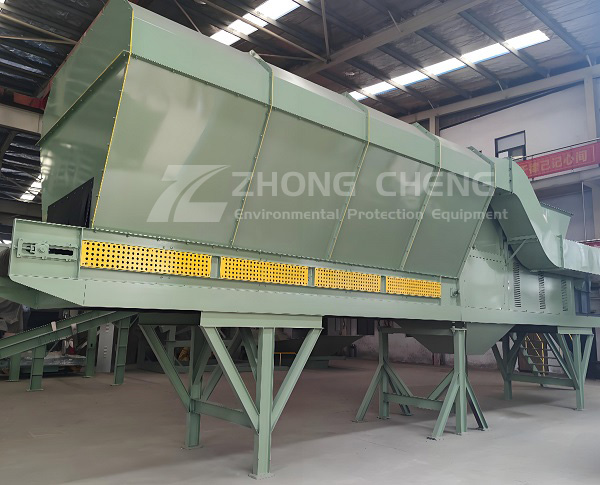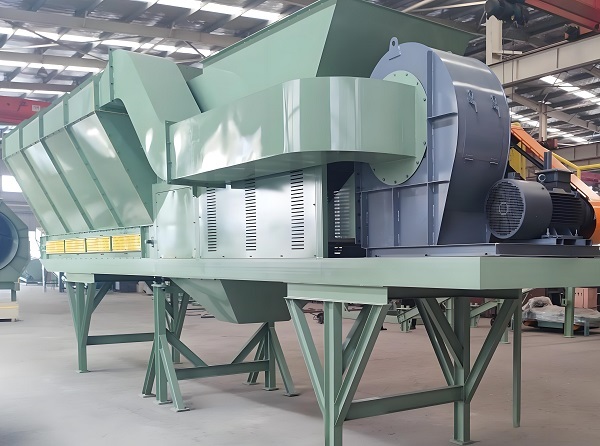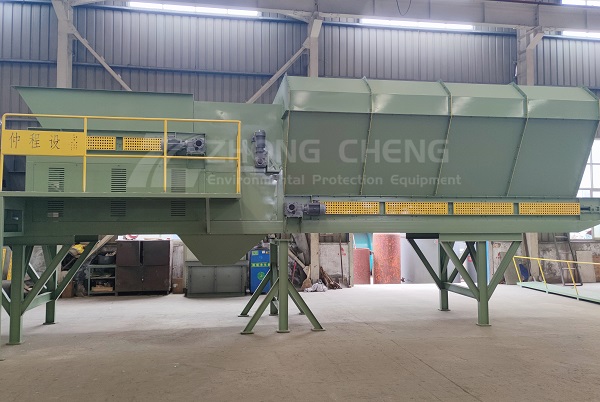Preface: In today's huge garbage disposal system, the wind sifter has become a key equipment for garbage screening with its unique working principle and significant advantages. With the rapid development of cities, the output of garbage continues to rise, and the composition becomes more and more complex. Traditional treatment methods are difficult to meet the needs, and the wind sifter came into being. It uses the principle of aerodynamics to efficiently separate different components in garbage, laying the foundation for subsequent treatment, and plays an irreplaceable role in the field of garbage disposal.
1. Working principle of wind sifter

Wind Sifter
The core principle of the wind sifter is to achieve screening based on the difference in the motion characteristics of different garbage components in the airflow. When it is working, the fan generates a strong airflow. After the garbage is sent to the air separation area, light materials (such as paper, plastic film, etc.) are easy to be blown up and move with the airflow due to their light weight and low density, and are finally collected; while heavy materials (such as metals, masonry, etc.) are large in mass and high in density, and are greatly affected by gravity. They settle quickly in the airflow and fall along a specific path, thereby achieving the separation of different components. For example, in common household garbage, waste paper floats to the collection area like light feathers under the air flow, while metal cans sink quickly due to their heavy weight.
2. Structural features of the sorting machine
The internal structure of the air sorter is exquisite. The feeding device evenly feeds the garbage into the air sorting area to ensure uniform distribution of materials and improve screening efficiency; the wind generating device provides a stable and appropriate airflow, and its wind speed and air volume can be adjusted according to the characteristics of the garbage; the separation area is the core place, and the various components of the garbage are separated under the synergistic effect of airflow and gravity; the collection device is responsible for recycling light and heavy materials for subsequent processing. In addition, some air sorters are also equipped with dust removal devices to reduce dust emissions and reduce pollution to the environment.
2. Specific process of air sorting garbage
Before the garbage enters the air sorter, it needs to be pre-treated. The first is crushing, breaking the larger garbage into suitable sizes to fully expose the components for easy air sorting and separation. For example, large pieces of furniture need to be broken into small pieces before they can be effectively screened in the air sorter. The second is magnetic separation, which uses magnetic separation equipment to separate magnetic materials (such as iron, nickel and other metals) from garbage to prevent them from affecting the air separation effect, and at the same time realize the recycling of metals.
The pre-treated garbage is evenly fed into the wind sifter by the feeding device. Under the action of wind power, light garbage (such as discarded plastic bags, packaging paper, etc.) is lifted by the air flow, moves along the air flow direction, and enters the light material collection area; heavy garbage (such as ceramic fragments, glass slag, etc.) sinks to the bottom because the gravity is greater than the wind force, and is collected by the conveying device. Some wind sifters also have an intermediate collection area for recycling materials with a density between light and heavy, such as some plastic bottles, wood blocks, etc.
The garbage after air separation needs to be processed later. Recyclable materials (such as paper, plastic, etc.) in light materials can be sent to the corresponding recycling plant for recycling; non-recyclable light materials (such as heavily contaminated paper) are incinerated for power generation or heating. Recyclable materials such as metals and glass in heavy materials are recycled, and the remaining bricks, stones, slag, etc. can be used for landfill or construction material production.
3. Factors affecting the screening effect of the wind sifter

Wind Sifter
The composition and properties of the garbage have a significant impact on the air separation effect. Complex composition and improper ratio of light and heavy materials will increase the difficulty of screening. For example, if there are too many light materials in the garbage, some heavy materials will be carried away; if the moisture content in the garbage is high, the light materials are easy to stick together, affecting their movement in the airflow and reducing the screening accuracy.
The wind speed and air volume of the wind sifter are crucial. If the wind speed is too low, the light materials cannot be effectively blown up; if the wind speed is too high, some heavy materials will be blown away by mistake. If the air volume is insufficient, the garbage cannot fully contact the airflow; if the air volume is too large, the energy consumption of the equipment increases and may damage the light materials. Therefore, the wind speed and air volume need to be accurately adjusted according to the characteristics of the garbage.
The structural design of the wind sifter will also affect the screening effect. The uniformity of the feeding device, the shape and size of the separation area, the position of the collection device, etc. are all related to the screening accuracy and efficiency. For example, uneven feeding will lead to local garbage accumulation, affecting screening; if the separation area is too small, the garbage will be discharged before it can be fully separated.
4. Advantages and limitations of wind sifters in garbage screening
The wind sifter has high screening efficiency and can quickly separate a large amount of garbage, which is suitable for large-scale garbage treatment plants. At the same time, it can effectively recycle light and heavy recyclables, improve resource utilization, and reduce the amount of landfill. In addition, the operation of the wind sifter is relatively simple, the equipment runs stably, and the maintenance cost is low.
The wind sifter also has certain limitations. It is difficult to accurately separate materials with similar densities (such as plastics of different materials), and they are easily affected by the humidity of the garbage. The screening effect is not good in a high humidity environment. At the same time, the wind sifter will generate certain noise and dust pollution when working, and it needs to be equipped with corresponding noise reduction and dust removal equipment.

Wind Sifter
5. Application cases and effects of wind sifters
In a large urban garbage treatment plant, the wind sifter works in conjunction with other equipment to process thousands of tons of domestic garbage every day. Through air separation, the recovery rate of recyclables has increased by 30%, and the amount of landfill has decreased by 40%, which has effectively alleviated the pressure of garbage disposal, reduced environmental pollution, and created considerable economic benefits.
PS: With the advancement of science and technology, wind sifters will continue to be intelligent. With the help of sensors and control systems, the garbage composition and equipment operating status can be monitored in real time, and parameters such as wind speed and air volume can be automatically adjusted to achieve accurate screening and improve equipment operating efficiency and reliability. In order to further improve the screening accuracy and resource recovery rate, the wind sifter will be deeply integrated with other screening technologies (such as magnetic separation, screening, etc.) to form a diversified and integrated garbage disposal system to meet more complex garbage disposal needs. In the future, wind sifters will pay more attention to environmental protection and energy saving. New materials and energy-saving technologies are used to reduce equipment energy consumption, reduce noise and dust emissions, and achieve green and sustainable development of garbage disposal. wind sifters have achieved remarkable results in the field of garbage screening. Although there are still shortcomings, with technological innovation and development, they will play a greater role in the garbage disposal industry and contribute to the reduction, resource utilization and harmless treatment of garbage.
Save Time! Get A Detailed Quotation Quickly.
